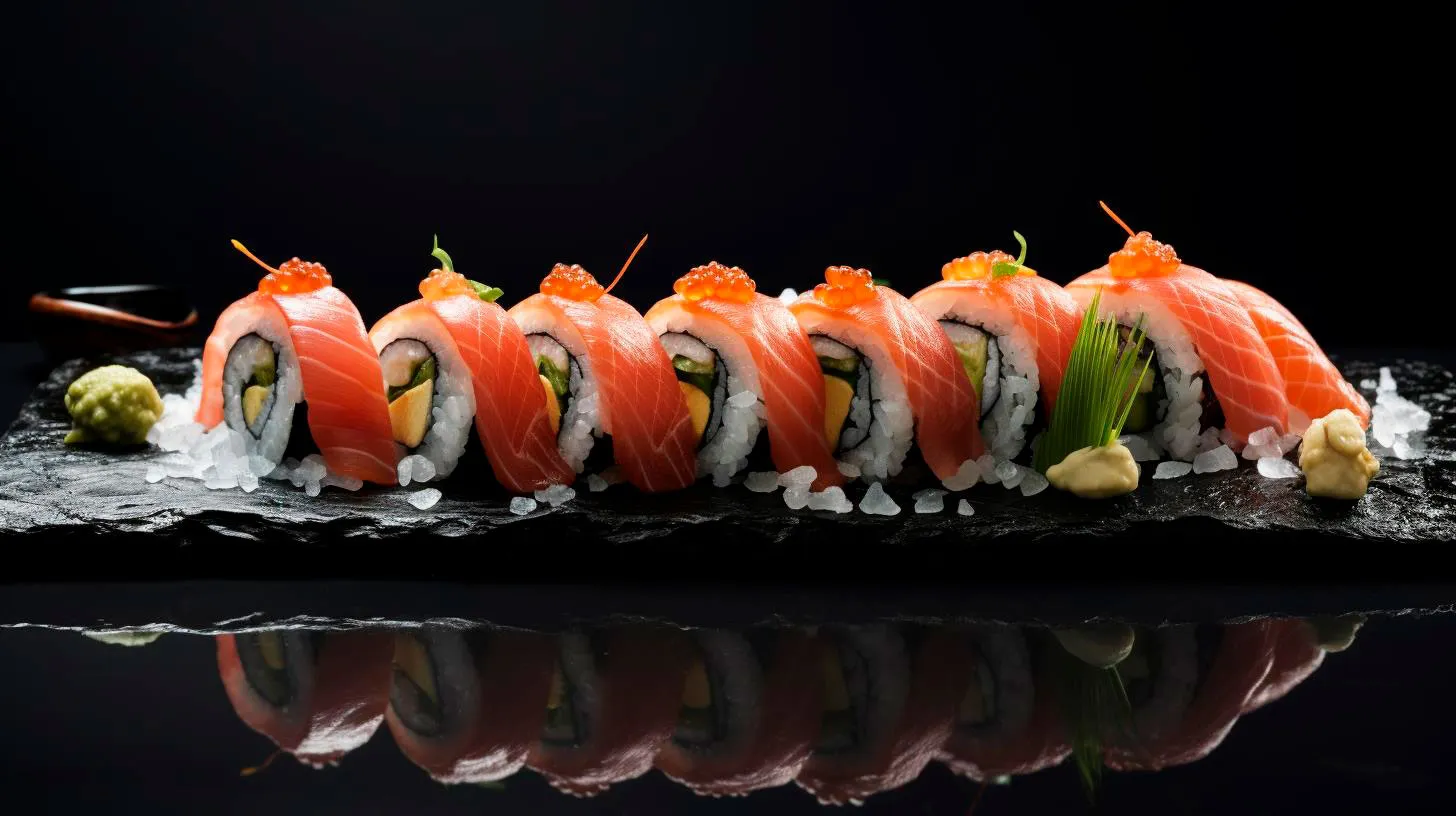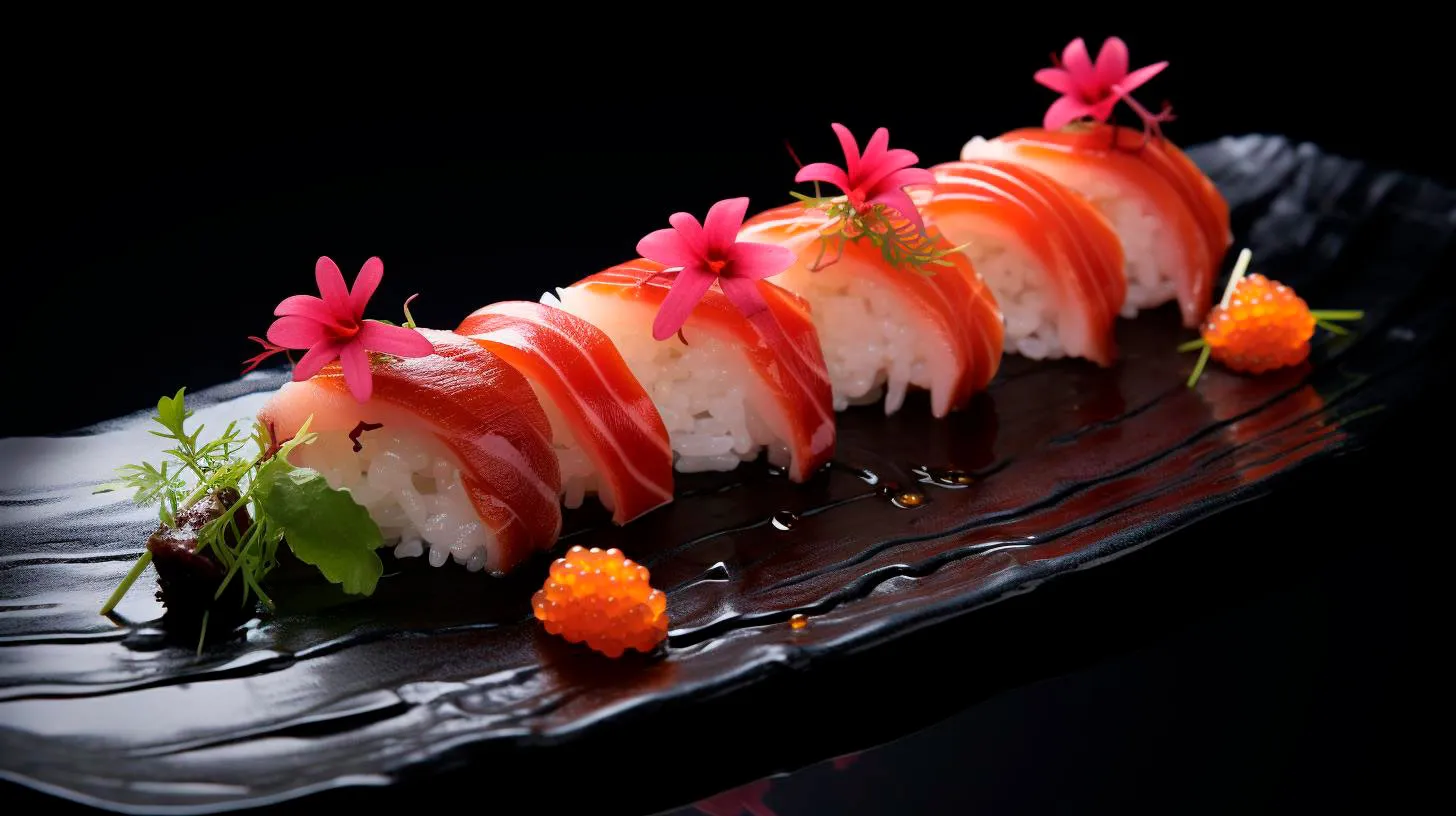Savoring Authenticity: Exploring Traditional Japanese Flavors in Gluten-Free Sushi
But fret not! In this article, we will unravel the world of gluten-free sushi, allowing you to revel in the traditional flavors of Japan without compromising your dietary needs.
The Rise of Gluten-Free Diet
Before diving into the details of gluten-free sushi, let’s take a moment to explore the rising popularity of gluten-free diets. In recent years, the number of people choosing to follow gluten-free lifestyles has been on the rise. Whether due to medical conditions, such as celiac disease or gluten intolerances, or personal choices to improve overall health, the avoidance of gluten has become a significant dietary trend.
According to recent statistics, the global gluten-free product market is expected to reach a value of $8.3 billion by 2026. This surge in demand has prompted restaurants and food manufacturers to adapt to this growing market, giving rise to an array of gluten-free alternatives in various cuisines, including Japanese cuisine.
The Essence of Traditional Japanese Sushi
Before delving into gluten-free variations, let’s acquaint ourselves with the essence of traditional Japanese sushi. Sushi is more than just raw fish and rice rolls; it embodies a rich cultural heritage spanning centuries. From the sourcing of fresh ingredients to the intricate art of preparing and presenting sushi, every element plays a crucial role in delivering an authentic experience.
Features and Advantages of Traditional Japanese Sushi:
- Focus on high-quality, fresh ingredients
- Delicate balance of flavors and textures
- Presentation as an art form
- High nutritional value and low in calories
- Rich in heart-healthy omega-3 fatty acids
Unleashing the Gluten-Free Sushi Magic
Now that we understand the foundations of traditional sushi, let’s discuss how gluten-free alternatives have made their way into this culinary art form. Gluten-free sushi is not just limited to the omission of gluten-containing ingredients; it goes beyond that, exploring unique and innovative ingredients to maintain the authentic Japanese flavors while catering to dietary restrictions.
Thanks to the advent of gluten-free soy sauce, rice wraps, and alternative fillings, sushi enthusiasts can now indulge in mouthwatering gluten-free rolls. The use of tamari sauce, made from fermented soybeans without wheat, ensures the umami-rich flavors without compromising the gluten-free aspect. Additionally, sushi rolls can be wrapped in rice paper, cucumber, or even thinly sliced vegetables as a substitute for traditional seaweed sheets.
Key Takeaways for Gluten-Free Sushi:
- Gluten-free soy sauce alternatives like tamari can be used in sushi
- Rice paper, cucumber, or thinly sliced vegetables can replace seaweed sheets
- Alternative fillings such as avocado, mango, or tofu provide diverse flavors
- Ensure dedicated gluten-free preparation area to avoid cross-contamination
Embracing the Gluten-Free Journey
As the demand for gluten-free options continues to grow, many sushi restaurants have started catering to the needs of gluten-sensitive patrons. By offering dedicated gluten-free menus and ensuring a safe preparation environment, these establishments are making Japanese cuisine accessible to all.
When dining out, it is essential to communicate your dietary requirements to the restaurant staff to guarantee a safe and enjoyable experience. By expressing your needs, you can make an informed decision while exploring the myriad flavors and combinations that gluten-free sushi has to offer.
Benefits of Embracing Gluten-Free Options:
- Increased inclusivity for individuals with gluten sensitivities
- Enhanced dining experiences through diverse flavor profiles
- Promotion of conscious eating and awareness of dietary needs
Embarking on a gluten-free journey doesn’t mean sacrificing the opportunity to savor traditional Japanese flavors. With the growing availability of gluten-free options, enjoying authentic sushi while adhering to your dietary needs is now a reality.
So, the next time you’re craving sushi, seek out gluten-free sushi establishments or unleash your culinary skills at home. Dive into the world of gluten-free sushi and let your taste buds embark on a delectable journey of authenticity and innovation.
Expert Tips Navigating Japanese Menus for Gluten-Free Sushi Lovers
But fear not! With a little knowledge and some expert tips, gluten-free sushi lovers can still enjoy the delicious flavors of Japan.
Understanding Gluten and Japanese Cuisine
Gluten is a protein found in many grains such as wheat, barley, and rye. It provides elasticity to dough and is commonly found in bread, pasta, and other wheat-based products. While traditional sushi rice does not contain gluten, some ingredients used in sushi rolls or sauces may include gluten-containing additives.
When dining at a sushi restaurant, it is essential to communicate your gluten-free requirements to the staff. Most Japanese chefs are well aware of dietary restrictions and are accommodating to special requests, especially in larger cities and popular tourist destinations. To ensure a safe dining experience, follow these expert tips:
1. Communicate Your Dietary Needs Clearly
When you arrive at the restaurant, inform the staff that you have a gluten intolerance or require a gluten-free meal. This will alert them to be extra cautious while preparing your food. Some restaurants may even have a separate gluten-free menu or can offer substitutes for gluten-containing ingredients.
Key Takeaway: Clear communication with restaurant staff is crucial to ensure they understand your dietary needs.
2. Know the Ingredients to Avoid
While traditional sushi rolls typically do not contain gluten, some ingredients frequently found in sushi can be problematic for those with gluten intolerance. Here are a few key ingredients to watch out for:
- Tempura: Deep-fried batter made with wheat flour
- Soy Sauce: Regular soy sauce contains wheat, so opt for gluten-free soy sauce instead
- Imitation Crab: Often made with wheat starch or gluten-containing fillers
Key Takeaway: Being aware of common gluten-containing ingredients will help you make informed choices when ordering.
3. Stick to Simple Sushi Rolls
Simplicity is often the key to finding gluten-free sushi options. Stick to basic sushi rolls like nigiri (fish on rice) or sashimi (sliced fish without rice). These options are usually free from gluten-containing ingredients and provide a delectable taste experience.
Key Takeaway: Opting for simpler sushi rolls reduces the risk of gluten exposure and ensures a safer dining experience.
4. Special Rolls with Gluten-Free Alternatives
If you’re craving a more elaborate sushi experience, some specialty rolls can be made gluten-free with simple modifications. Here are a few popular rolls and gluten-free alternatives:
- California Roll: Substitute imitation crab with fresh or marinated crab or shrimp
- Spicy Tuna Roll: Replace soy sauce with gluten-free soy sauce and confirm the spicy mayo is gluten-free
- Vegetable Roll: Enjoy a variety of fresh vegetables wrapped in rice and seaweed
Key Takeaway: With slight modifications, many specialty rolls can be made gluten-free, allowing for a more diverse sushi experience.
5. Opt for Gluten-Free Side Dishes
Japanese cuisine offers a wide range of gluten-free side dishes that complement your sushi experience. Some popular options include:
- Miso Soup: A traditional Japanese soup made from fermented soybeans
- Edamame: Steamed soybean pods sprinkled with sea salt
- Seaweed Salad: A refreshing salad made from various types of seaweed
Key Takeaway: Including gluten-free side dishes adds variety and enhances your dining experience.
The Bottom Line
While navigating menus in Japanese restaurants can appear challenging for gluten-free sushi lovers, armed with the right knowledge, it can be an enjoyable and safe experience. Remember to communicate your dietary needs, be aware of ingredients to avoid, and opt for simpler sushi rolls or modified specialty rolls. With these expert tips, you can savor the flavors of authentic Japanese cuisine while keeping your gluten-free diet intact.
So, the next time you find yourself craving sushi, don’t hesitate to explore a Japanese restaurant and indulge in their gluten-free offerings. Your taste buds will thank you!
Delightful Options Gluten-Free Sushi for Health-Conscious Diners
Fortunately, there are now delightful gluten-free sushi options available for health-conscious diners, ensuring that everyone can enjoy this delectable cuisine without any dietary restrictions.
The Rise of Gluten-Free Sushi
Sushi has gained immense popularity in recent years, both in traditional Japanese cuisine and international adaptations. As more people embrace healthier eating habits and specific dietary requirements, the demand for gluten-free options has also increased. Gluten, a protein found in wheat, barley, and rye, can cause discomfort and health issues for individuals with gluten sensitivities or autoimmune conditions such as celiac disease.
The Benefits of Gluten-Free Sushi
Gluten-free sushi not only caters to individuals with dietary restrictions but also offers several benefits for those seeking a healthier lifestyle:
- Improved Digestion: Going gluten-free can help alleviate digestive issues for individuals with gluten sensitivities. By choosing gluten-free sushi, you can enjoy a delicious meal without worrying about unpleasant digestive symptoms.
- Inclusive Dining: Having gluten-free sushi options available ensures that everyone, regardless of their dietary restrictions, can join in and enjoy a sushi feast together.
- Diverse Menu: Gluten-free sushi has sparked creativity in sushi chefs, leading to the development of exciting and innovative flavor combinations using alternative ingredients.
- Increased Health Awareness: The availability of gluten-free sushi promotes awareness about different dietary needs, encouraging other restaurants to cater to a wider range of dietary preferences.
Popular Gluten-Free Sushi Options
The sushi industry has embraced the demand for gluten-free options, resulting in a wide variety of choices for health-conscious diners. Some popular gluten-free sushi options include:
- Sashimi: Delight in thin slices of raw fish or seafood without any rice or gluten-containing ingredients. It’s a pure, protein-packed delight.
- Naruto Rolls: Instead of using traditional sushi rice, Naruto rolls substitute it with thinly sliced cucumber. These rolls are refreshing and low in carbohydrates, making them a suitable option for those watching their calorie intake.
- Black Rice Sushi: Black rice, also known as forbidden rice, is a healthier alternative to white rice. It is rich in antioxidants and provides a nutty flavor to sushi rolls.
- Rice Paper Sushi Rolls: By using rice paper instead of traditional seaweed sheets, these rolls are not only gluten-free but also lighter in texture. They are perfect for those who prefer a different twist to their sushi experience.
Key Takeaways
Gluten-free sushi has become an essential part of the dining culture for health-conscious individuals. With a focus on dietary inclusivity and innovative alternatives, sushi restaurants have successfully catered to those with dietary restrictions. Here are the key takeaways:
- Gluten-free sushi provides a healthy and delicious option for individuals with gluten sensitivities.
- Choosing gluten-free sushi promotes inclusion and allows everyone to enjoy sushi together.
- There is a wide range of gluten-free sushi options available, including sashimi, Naruto rolls, black rice sushi, and rice paper sushi rolls.
- Gluten-free sushi encourages other restaurants to be more aware of different dietary preferences and needs.
Next time you visit a sushi restaurant, be sure to explore their gluten-free options. Indulge in the delightful flavors, impeccable presentation, and know that you’re making a healthy choice that suits your dietary needs. Gluten-free sushi allows you to immerse yourself in the world of sushi without any limitations, making every dining experience a delightful one.
Beyond the Basics Creative Variations on Gluten-Free Sushi Rolls
In this article, we will explore some unique and delicious gluten-free sushi roll options that are both healthy and full of flavor.
1. Rainbow Roll
The Rainbow Roll is as beautiful as it is delicious. It is filled with a combination of fresh and colorful vegetables like cucumber, avocado, and bell peppers, along with your choice of protein such as cooked shrimp or crab. The roll is then adorned with thin slices of fresh fish like salmon, tuna, and yellowtail, giving it a vibrant appearance that resembles a rainbow. The combination of flavors and textures in this roll will leave you craving for more.
- Feature: A colorful and visually appealing sushi roll.
- Advantage: Packed with fresh vegetables and protein.
- Key Takeaway: The Rainbow Roll offers a burst of flavors that will impress both your taste buds and your Instagram followers.
2. Tempura Roll
Get ready to indulge in the crispy goodness of tempura with this mouthwatering sushi roll. Instead of traditional sushi ingredients, this roll features lightly battered and deep-fried shrimp, sweet potato, or other vegetables. The crunch of the tempura coating combined with the creaminess of avocado and the tanginess of mayo-based sauces creates an irresistible flavor combination. The Tempura Roll offers a satisfying and crunchy twist to the traditional sushi experience.
- Feature: A sushi roll with a crunchy tempura coating.
- Advantage: Perfect for those who enjoy a crispy texture in their sushi.
- Key Takeaway: The Tempura Roll adds a new dimension of flavor and texture to your gluten-free sushi options.
3. Spicy Mango Roll
If you enjoy a little kick of spice in your sushi, the Spicy Mango Roll is a must-try. This roll combines the sweetness of ripe mango with the heat of spicy mayo or Sriracha sauce. The creamy avocado and crunchy cucumber complement the spicy flavors, creating a balanced and satisfying taste sensation. The addition of mango adds a subtle sweetness that contrasts perfectly with the spiciness, making this roll a favorite among sushi enthusiasts.
- Feature: A sushi roll with a sweet and spicy flavor profile.
- Advantage: The combination of mango and spice creates an explosion of flavors.
- Key Takeaway: The Spicy Mango Roll is a delightful combination of sweet, spicy, and savory flavors.
4. Quinoa Sushi Roll
For those looking for a healthier alternative to traditional sushi rolls, the Quinoa Sushi Roll is the perfect choice. Instead of using rice, this roll is made with protein-packed quinoa. The nutty flavor and slightly chewy texture of quinoa pair well with a variety of fillings, such as fresh vegetables, tofu, or cooked shrimp. This roll is not only gluten-free but also offers additional nutritional benefits, making it an excellent option for health-conscious sushi lovers.
- Feature: A gluten-free sushi roll made with quinoa.
- Advantage: Provides a healthier alternative with added nutritional benefits.
- Key Takeaway: The Quinoa Sushi Roll offers a delicious and nutritious twist on traditional sushi.
Expand Your Sushi Horizons
Don’t limit yourself to the same old sushi rolls. With these creative and gluten-free variations, you can take your sushi experience to a whole new level. Whether you’re looking for vibrant colors, crunchy textures, spicy flavors, or healthier options, these rolls have something for everyone. So, next time you’re craving sushi, think beyond the basics and explore the world of creative gluten-free sushi rolls.



